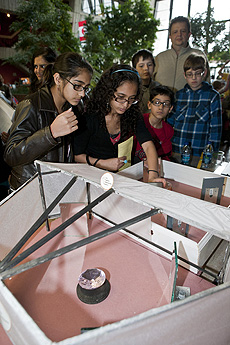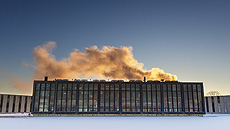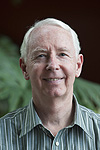|
Wednesday, Feb. 5
- Breakfast: breakfast strata
- Breakfast: ham, egg and cheese English muffin
- Grilled-chicken quesadilla
- Smart cuisine: herb and lemon fish
- Shepherd's pie
- Italian antipasto panino
- Pasta bar
- Vegetarian harvest moon vegetable soup
- Texas-style chili
Wilson Hall Cafe menu |
|
Wednesday, Feb. 5
Lunch
- Chicken roulade with herbed cheese
- Spinach orzo
- Swedish apple pie
Friday, Feb. 7
Dinner
- Spinach salad with cranberries and pine nuts
- Flank steak with caramelized onions and balsamic glaze
- Walnut-crusted potato and blue cheese cakes
- Brussels sprouts
- Profiteroles au chocolat
Chez Leon menu
Call x3524 to make your reservation.
|
|
Fermilab Family Open House - Sunday, Feb. 9
 |
| Kids enjoy a science demonstration at Fermilab's Family Open House. Photo: Cindy Arnold |
Part of Fermilab's vision is to inspire the next generation of scientists and engineers. There's no better way to do that than to give them a hands-on, close-up encounter with science. And there's no better opportunity for such an encounter than the annual Family Open House, which will take place in Wilson Hall on Feb. 9 from 1-5 p.m.
The Family Open House is one of the most popular events Fermilab hosts. Thousands of people, including children of all ages, are expected to attend, and they'll get to talk one on one with scientists and learn about physics in fun and informative ways. The Open House features performances by Jerry "Mr. Freeze" Zimmerman, demonstrating the (very) cool effects of liquid nitrogen, a talk from scientist Brian Nord exploring the fabric of space-time and science exhibits created by students at four local schools.
"We want to get kids doing activities that get them excited about science," said Spencer Pasero, program leader in Fermilab's Education Office. "We want them to come in, have fun and think about science as something they could do."
No registration is required to attend the Family Open House.
—Andre Salles
|
Light and vapor
 |
| Water vapor from the Central Utility Building is lit by the setting sun.
Photo: Marty Murphy, AD |
|
Coming soon: an improved SharePoint experience
Many folks at Fermilab use SharePoint to collaborate via the Web. It provides a space to host meeting agendas and minutes, a place to organize and share group or project information and a way to handle multiple people updating a document. SharePoint is a Web-based solution that we can customize to address the content management needs of the scientific, business and technical communities at Fermilab.
The Core Computing Division will upgrade Fermilab to SharePoint 2013 by the end of March. Our implementation, to be called FermiPoint, will offer a more social experience — tagging, easier navigation, easier content and document sharing (in fewer clicks) — and a significantly improved user experience, especially for those using Linux or Mac operating systems or non-Microsoft browsers.
The migration process will have an impact on those who have existing SharePoint sites. Site owners will receive email within the next few weeks regarding this impact and what they need to do to prepare for migration to FermiPoint.
For more information, including frequently asked questions about and benefits of FermiPoint, see the FermiPoint Migration page.
—Keenan Newton
|
STEM education: preparing students to succeed
From energy.gov, Jan. 31, 2014
As the President mentioned in his State of the Union address this week, we must prepare students with the skills necessary to succeed in the new economy — especially skills in science, technology, engineering and math (STEM). By supporting education and job training, we can strengthen the work force and ensure that Americans who are willing to work hard can access the ladders of opportunity into the middle class. The Energy Department and its 17 national labs are tackling this challenge head on in communities across the country. As a Department based in science and technology for all of our energy, environment, science and national security missions, a STEM-educated workforce is essential for our continuing success in serving the nation.
One way the national labs are preparing the next generation of STEM professionals is through educational opportunities and training programs.
Read more
|
Soon, the coldest place in the known universe will be on ... the International Space Station
From The Atlantic, Feb. 3, 2014
Space, on top of everything else, is cold. Really cold. The cosmic background temperature — the temperature of the cosmic background radiation thought to be left over from the Big Bang — is 3 Kelvin, or -455 degrees Fahrenheit. Yet there's variation within that. Solar winds can reach millions of degrees Fahrenheit. And then there's the Boomerang Nebula, the cloud of gas puffed out by a dying star in the constellation Centaurus. The Boomerang Nebula clocks in at a just-slightly-more-frigid-than-average -458 degrees Fahrenheit, making it, officially, the coldest spot in the known universe.
But that's about to change. Soon, it seems, the coldest spot in the known universe will be ... the International Space Station.
Read more
|
|
The building manager's toolkit
 |
|
Kent Collins
|
Kent Collins, acting head of the Facilities Engineering Services Section, wrote this column.
I came to Fermilab in 1990 as the Wilson Hall building manager and have held a number of other positions over the years. I now have the good fortune to lead the experienced and dedicated FESS workforce.
We support the laboratory's divisions, sections and centers by providing basic maintenance for all buildings, as well as managing the site infrastructure. Building managers are responsible for day-to-day management of the laboratory buildings, and FESS has developed a few tools to simplify building managers' jobs and to facilitate maintenance and real property reporting, which Fermilab provides to DOE.
Ten years ago FESS started the development of a geographic information system (GIS), a mapping system that shows our site infrastructure and other conventional map features such as underground utilities, tunnels and many other layers. The GIS is integrated with other databases to provide a visual tool to help building managers access information about their facilities.
Recently we created a link for each building in the GIS, allowing one to view the active equipment in the FESS maintenance database. This helps building managers better understand the components that keep their facilities operational. While this tool is not available off site, the GIS is available to all on-site users. Contact Joe Pygott for assistance in navigating this application.
Another tool we've developed helps manage Director's Policy no. 18, the construction modification review process. The FESS Engineering Department reviews proposed conventional construction and building modifications for compliance with Fermilab policies, sustainability and compatibility with land-use plans. We maintain records of all projects designed by FESS and expect other divisions, sections and centers to retain records of the projects they've designed.
A new design review tool provides a convenient way to submit drawings and specifications for FESS to review and record comments and revisions. Final plans are maintained in a searchable database.
The FESS GIS, FESS design review form and other FESS information such as the list of FESS engineering projects can be accessed from the FESS home page.
|
Here to help in your medical coverage transition
On Jan. 1, medical coverage for Fermilab employees transitioned to Blue Cross Blue Shield and Prime Therapeutics. Throughout the past month, the Benefits Office has received questions regarding the BCBS transition, as employees are beginning to use their coverage under BCBS. You can refer to the frequently asked questions document for more information or contact the Benefits Office at x4361 or x3395 with questions.
|
ESH&Q weekly report, Feb. 4
This week's safety report, compiled by the Fermilab ESH&Q Section, contains three incidents.
An employee tripped, hitting his face against a cabinet and receiving a laceration. He received first-aid treatment.
A small piece of metal fell into and was embedded in an employee's eye while he was welding. He was wearing a face shield. The employee received medical treatment. This is a DART case.
An employee struck his head against a light fixture, resulting in a small abrasion. He received first-aid treatment.
Find the full report here.
|
Diamond: Britain's answer to the Large Hadron Collider
From The Guardian, Feb. 1, 2014
The darling of particle physics might be the Large Hadron Collider (LHC) at Cern, but as a practical tool it's no match for the UK's Diamond Light Source. Located at the Rutherford Appleton Laboratory campus at Harwell in Oxfordshire, Diamond is an alchemist's dream, a place where beams of light 10,000 times brighter than the sun are deployed to probe the nature of everyday things.
Diamond is the Marmite of the physics world. Just as the sticky gunk left over from the brewing process was repurposed as a savoury spread, the light that streams from Diamond was originally the waste product of a particle accelerator.
Read more
|
|